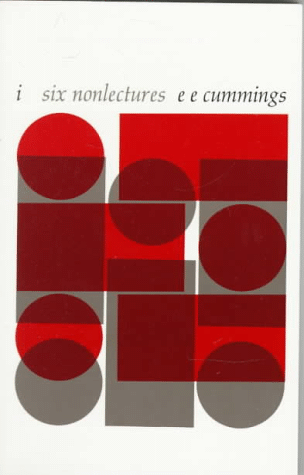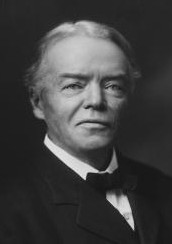| i: six nonlectures
First published by Harvard University Press in 1953 and never out
of print, i: six nonlectures are the six Charles Eliot Norton "lectures"
which Cummings delivered in the Sanders Theatre at Harvard University in
1952-1953. As the title indicates, the the book is about Cummings' lowercase
"i" --his self. In the first three nonlectures, Cummings talks about the influences
that formed that self--his family, his early life in Cambridge, MA, his
reading, and his encounters with notable places: Norton's Woods, New York
City, and Paris. He ends each nonlecture with readings from his own and
others' poems. The last three nonlectures are devoted to Cummings' writings--his
poems, plays (Him and Santa Claus), and prose works (The Enormous Room and Eimi).
Written in the poet's idiosyncratic style, these nonlectures are amusing,
entertaining, and enlightening, telling you more about the Cummings world-view
than any of his other books.
Order from Amazon.com
|

|
Notes for E. E. Cummings' i: six nonlectures [1953]
(8) my father: Cummings' father, Edward Cummings, was a sociology
professor and later a Unitarian minister. When he was in his teens and twenties,
the poet rebelled against his father, but later saw him as a hero of the
self (see Kennedy, Dreams 100-104; 161-163; 205-206; 385-386 and
Kennedy, Revisited 111).
(8) a spiritual roofgarden = most likely, the Rev. Cummings was
referring to fancy rooftop restaurants (complete with dance-band orchestras,
etc.), popular among the bourgeoisie at the turn of the last century. In
his sermon-speech, "A
Predominant Emphasis on Social Ideals and Endeavors" (1913), Cummings'
father discusses how he interprets Jesus' pronouncement that "The kingdom
of Heaven is at hand" (Matthew 4:17):
He [Jesus] meant Plato's ideal kingdom of Heaven was at hand.
He did not mean that ridiculous spiritual roof-garden in the next world where
the elect few of the "redeemed" are supposed to rejoice in everlasting bliss,
in utter disregard of the endless agonies of the damned below. That is a
barbarous and ridiculous conception of the kingdom of Heaven. At best, according
to that ridiculous religion, our ancestors seemed to think there was going
to be very little to do in that heaven, except join the choir and sing loud
enough so that you should not hear the moans of the people in the basement;
and some even thought one of the joys of heaven was to be found in looking
over the battlements of this spiritual roof-garden and congratulating yourself
that you were not in the burning lake of brimstone and fire below. Obviously,
anybody who really deserved to be in heaven would immediately insist on
starting a social settlement in hell. And in spite of all his narrowness
and limitations, Plato's heavenly ideal was far more what Jesus had in mind
than this old Christian conception. (51-52)
(9) William James (1842-1910): Pragmatist philosopher, early psychologist,
and brother of novelist Henry James.
(9) concentration camp: During World War I, Cummings was jailed
for supporting his friend Slater Brown, who wrote letters home saying that
the Germans were probably not such bad folks after all. Cummings’ book about
this experience is called The Enormous Room.
(11) nothing false and possible is love: first stanza of a sonnet
by Cummings (CP 574). The next line of the poem reads: "must’s a schoolroom
in the month of may:"

(25) professor Royce: Josiah Royce (1855-1916), professor of philosophy
at Harvard, colleague of James. See note to "curtains part" (CP 230). Photo of Josiah Royce
(with bow tie) at right.
(32) Norton's Woods, formerly the estate
of Charles
Eliot Norton (1827-1908), and currently the grounds of the American Academy of Arts and Sciences.
Links to accounts of the visits of Cummings Society members to 104 Irving
St., Norton's Woods, and beyond may be found on the contents page for Spring 20 (2013). Of
course, by mentioning Norton's Woods and the "palace" of Charles Eliot Norton,
Cummings was taking the Norton
Lectures further into the realm of "nonlectures," which speak of childhood
adventures and "trivialities" like Professor Royce's "necktie crisis" (6).
(48) Howard Street . . . Scollay Square Howard St. was in Scollay
Square, Boston, site of the Old Howard Theatre,
a burlesque house. Long since demolished by "illustrious punks of Progress"
(CP 438), Scollay Square and the Old Howard were for years "famous for supplementing
the curricula of Harvard students. 'Always Something Doing, One to Eleven,
at the Old Howard' read its ads in the Boston Globe, followed by the titillating
phrase, '25 Beautiful Girls 25'" (Park). See also
the web page "A
brief, pictorial history of Scollay Square."
(48) Bernhardt = Sarah Bernhardt,
French actress, born Rosine Bernhard (1844-1923).
Pavlova = Anna
Pavlova (1881-1931), Russian ballet dancer. Nix On The Glowworm
= Nix on the
Glow Worm, Lena, a comic song from 1910 with lyrics by Ballard Macdonald
and music by Harry Carroll. Cummings misremembers: Pavlova actually danced
to "The Glow-Worm"
(1902), a musical composition by Paul Lincke. "Nix on the
Glow Worm, Lena" is about a certain Lena who plays "The
Glow-Worm" badly.
Link: Pavlova
dancing "The Dying Swan.
(48) Polaire
= Emilie-Marie Bouchard (1879-1939), French actress and cafe-concert
singer. Polaire singing "Tchique Tchique."
Another site on Polaire.
The Turkey Trot and The Bunny
Hug = Popular dances.
Everybody's Doing It [Now],
Alexander's
Ragtime Band, Has Anybody Here Seen Kelly,
There's
A Little Bit Of Bad In Every Good Little Girl, On The Banks Of The Saskatchewan, and Here
Comes My Daddy Now (Oh Pop! Oh Pop! Oh Pop!) = Popular songs,
circa 1911-1916. Here's a performance of the chorus from "Here Comes My Daddy
Now" (lyrics by L. Wolfe Gilbert, music by Lewis
F. Muir):
Here comes my daddy now (oh
pop! oh pop! oh pop!)
Here comes my daddy now (oh pop! oh pop! oh pop!)
See that grip in hand,
It holds something grand
That he brought for me
From across the sea.
Here comes my daddy now (oh pop! oh pop! oh pop!)
Here comes my daddy now,
And I will not have to pine,
Here comes that man of mine,
Here comes my daddy now.
Links:
(49)
Gertrude Hoffman = vaudeville dancer
and leader of a troupe known as the "Hoffman Girls." She was the first in
North America to perform (albeit in pirated versions) dances of the
Ballets Russes. See "
Gertrude Hoffman"
(Dance Collection Danse).
Mr. Sumner = John S. Sumner,
"executive secretary of the
New York Society for the Suppression of Vice" (Daniels 81).
(50) lugete, o Veneres: Catullus, poem 3, "O Venus and her cupids
/ and all that's moved by beauty in man, mourn / for my sweetheart's sparrow
is dead." See the note to the poem "o pr" (CP 392). See also the notes to EIMI for pages
323 / 312 and 447 / 426.
(51) labuntur anni: Horace, Odes II.14, Ah, Postumus, Postumus,
how fleeting / "the swift years--prayer cannot delay / the furrows of imminent
old-age / nor hold off unconquerable death." (Cummings refers to this poem
at least three times in the Complete Poems.
See notes to CP 234, CP 492, and CP 986.)
(51) Ποικιλόθρον', ἀθάνατ' Ἀφρόδιτα = Poikilothron' athanat' Aphrodita = the
first line of Sappho's "Hymn to Aphrodite":
"On the throne of many hues, deathless Aphrodite" (Rayor 51). See also Elizabeth
Vandiver's translation: "Hymn to Aphrodite."
(51) that glorious human being = poet John Keats. Cummings quotes
from Keats' letter to Benjamin Bailey, November 22, 1817.
(54) whose any mystery . . . Cummings quotes here from lines 7-8
of his sonnet "you shall above all things be glad and young" (CP 484).
(68) 144 should read "1944."
(79) I drew a picture of it —visible on the covers of the 1927 and
1955 editions of Him and reproduced on our Him
page. Cummings also recorded this "artist-as-acrobat" scene on his first
album, E. E. Cummings Reading His Poetry
(1953), now called Essential E. E. Cummings (click on
"Audio Excerpt"). His nonlecture commentary on the scene was reprinted
in the liner notes to the original LP.
(111) believing and thinking automation should read "believing and
thinking automaton."
Works Cited
- Cummings, Edward. "A
Predominant Emphasis on Social Ideals and Endeavors." Proceedings at the
Forty-Sixth Annual Meeting of the Free Religious Association. Boston:
Free Religious Association, 1913. 47-57.
- Cummings, E. E. Complete Poems, 1904-1962.
New York: Liveright, 1994. Abbreviated CP.
- Daniels, Jonathan. The Time Between the Wars: Armistice to Pearl
Harbor. Garden City: Doubleday, 1966.
- Kennedy, Richard S. Dreams in the Mirror: A Biography of E.
E. Cummings. New York: Liveright, 1980.
- ---. E. E. Cummings Revisited. New York: Twayne, 1994.
[Twayne's United States Authors Series No. 637.]
- Rayor, Diane, ed. and trans. Sappho's Lyre. Berkeley: U
of California P, 1991.
Back to:
EEC Notes page
People, Places, and Publications page
Bibliography / Works Cited page
Chronology
Spring home page

